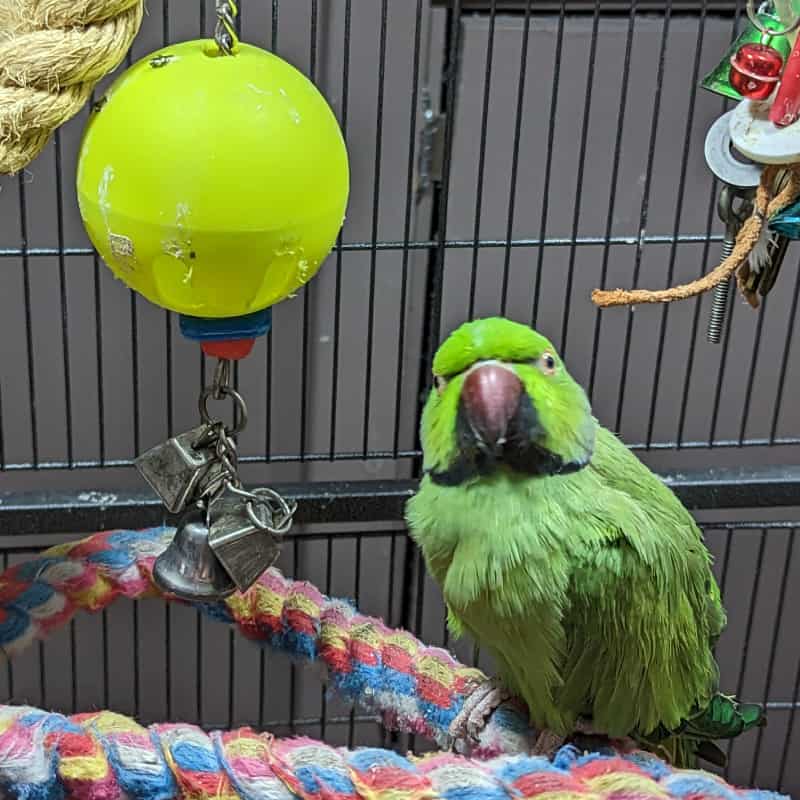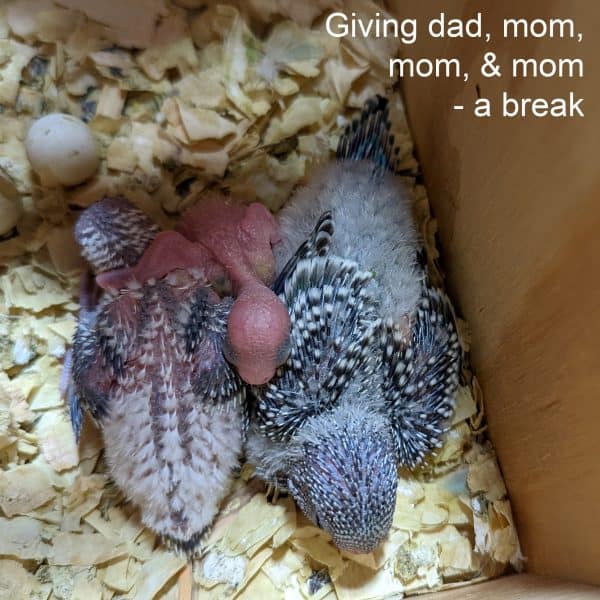
How to Create a Stimulating and Safe Birdcage Environment
Last Updated on by Mitch Rezman
Creating a stimulating and safe cage environment is essential for the mental and physical health of your parrot.
These clever and curious birds need more than just food and water; they require constant mental stimulation, physical exercise, and a sense of safety.
From choosing the right cage size to adding perches, swings, and toys, each element of their habitat contributes to their overall happiness and well-being.
Selecting the Appropriate Cage Size
One of the most critical aspects of setting up a parrot’s home is choosing a cage that’s large enough to allow them plenty of room to move, stretch their wings, and explore. Parrots vary greatly in size, so their cage needs differ accordingly. Here’s a breakdown of general guidelines:
Small Parrots (e.g., Budgies, Lovebirds): Minimum cage size should be 18″x18″x24″ with bar spacing between 0.5″-0.75″.
Medium Parrots (e.g., Cockatiels, Conures): A cage size of at least 24″x24″x30″ with bar spacing around 0.75″-1″.
Large Parrots (e.g., African Greys, Amazons): Minimum cage dimensions should be 36″x24″x48″ with bar spacing of 1″-1.5″.
Extra Large Parrots (e.g., Macaws, Cockatoos):** Opt for a cage size of at least 40″x30″x60″ with bar spacing around 1″-2″.
Larger is almost always better! Your parrot should be able to fully extend its wings in all directions and have enough space to climb, play, and explore.
Now lets forget all that.
Some veterinarians recommend a bird cage’s width should be twice the length of a birds wing span.
What I recommend is evaluating the birds life style.
If a bird is outside of its cage all day long they need less cage if they are simply sleeping in it.
As long as they can stretch their wings, they should be fine.
Ideal Cage Materials and Design
Safety is paramount when selecting a cage. The material of the cage must be durable, non-toxic, and easy to clean.
Safe Materials: Stainless steel and powder-coated metal are ideal. They resist rust and do not contain harmful toxins. While more expensive, stainless steel is extremely durable and long-lasting.
Avoid: Cages with zinc or lead coatings, as these can be toxic if ingested by curious parrots. Additionally, plastic cages are generally not recommended due to their fragility and potential for harmful chemical leaching.
Bar Spacing: Make sure the bars are spaced appropriately for your parrot’s size to prevent escape or injury. Smaller birds require closer bars, while larger parrots need wider spacing but should not be able to stick their heads through the bars.
Perches: Essential for Foot Health and Engagement
Perches are crucial for your parrot’s physical health. Different textures and diameters help maintain strong, healthy feet and prevent foot problems like bumblefoot.
Types of Perches: Natural wood perches (e.g., manzanita, java wood) are great as they offer varied textures and are safe for chewing. Rope perches provide a soft surface for standing and climbing, while concrete perches help keep nails trimmed.
Size Matters: Ensure perches vary in thickness to exercise different parts of the feet. For small parrots, perches around 0.5″-1″ in diameter work well. Medium parrots need 1″-2″, and large parrots do best with 2″-3″ diameter perches.
Placement: Avoid placing perches directly over food and water dishes to prevent contamination. Include perches at different heights to encourage climbing and exploration.
Incorporating Swings and Climbing Structures
Swings and climbing structures provide much-needed physical exercise and mental stimulation. They allow your parrot to engage in natural behaviors like swinging, climbing, and balancing.
Swings: Choose sturdy swings made of natural materials like wood or rope. Swings with different textures and shapes keep your bird interested.
Climbing Structures: Rope ladders, boings (spiral ropes), and hanging vines can be used to create a mini jungle gym. Just ensure all materials are bird-safe and securely attached to prevent accidents.
The Importance of Toys for Mental and Physical Stimulation
Toys are a parrot’s version of entertainment and are essential for mental stimulation. Without enough mental activity, parrots can develop behavioral issues such as feather plucking.
Types of Toys:
- Foraging Toys: These require parrots to work for their treats, stimulating their natural foraging instincts.
- Chew Toys: Ideal for parrots to satisfy their need to chew, helping keep beaks trimmed.
- Puzzle Toys: These provide cognitive challenges, great for intelligent species like African Greys.
- Interactive Toys: Bells, mirrors (for some species), and toys that make sounds engage a parrot’s curiosity and playfulness.
Toy Rotation for Continued Engagement
Rotating toys regularly keeps your parrot interested and curious. Birds can quickly become bored with the same toys, so changing them out every week or two keeps their environment fresh.
Introduce New Toys Gradually: Parrots can be wary of new objects. Introduce new toys outside the cage first, allowing your bird to get accustomed to them before placing them inside. Always do this during the day as late after noon and early evening can cast scary shadows.
Environmental Enrichment Beyond Toys**
To keep your parrot engaged, enrich their environment with natural elements and interactive experiences.
Natural Elements: Incorporate bird-safe branches, leaves, or even small potted plants in the cage to mimic a natural habitat.
Playtime Outside the Cage: Spend time daily letting your parrot explore outside their cage under supervision. Interactive play strengthens the bond between you and your bird.
Music and Sounds: Parrots often enjoy music, nature sounds, or even the sound of a TV or radio playing softly in the background.
Maintaining a Clean and Safe Cage Environment
Regular cleaning and maintenance are vital to ensure a healthy environment.
Cleaning Routine: Clean food and water dishes daily. Wipe down perches and cage bars weekly, and perform a thorough cage cleaning at least once a month.
Inspect Toys and Perches: Routinely check toys and perches for wear and tear, and replace any items that show signs of damage to prevent injury.
Conclusion
Creating a safe and stimulating environment for your parrot involves more than just picking out a cage. From selecting the right size and materials to incorporating perches, swings, toys, and natural elements, every choice you make impacts your parrot’s physical and mental health. A well-planned environment keeps your parrot happy, active, and thriving, leading to a longer, healthier life.
FAQs
- How often should I change my parrot’s toys?
Aim to rotate toys every 1-2 weeks to keep your parrot mentally stimulated and prevent boredom.
- What type of perches are best for my parrot?
A variety of natural wood, rope, and concrete perches in different sizes is ideal for promoting foot health.
- Is it okay to let my parrot out of its cage?
Yes! Supervised time outside the cage is crucial for exercise, exploration, and social interaction.
- How do I know if a cage material is safe for my parrot?
Stick to stainless steel or powder-coated metal cages, avoiding those with zinc or lead coatings, which are toxic to birds.
- Can parrots have plants in their cage?
Yes, but ensure the plants are non-toxic to birds.
Safe options include spider plants, pothos, and African violets.
Written by Mitch Rezman and the Windy City Parrot Content Team
Author Profile
Latest entries
 The Traveling BirdJune 26, 2025Can You Name 5 Parrot Species That Are Living Wild in the USA?
The Traveling BirdJune 26, 2025Can You Name 5 Parrot Species That Are Living Wild in the USA? Bird BehaviorJune 26, 2025How is it Parrots Are Problem Solvers Social Animals and Even Use Tools?
Bird BehaviorJune 26, 2025How is it Parrots Are Problem Solvers Social Animals and Even Use Tools? Bird & Parrot AnatomyJune 25, 2025How a Tiny Chemical Modification Makes Parrots Nature’s Living Paintings
Bird & Parrot AnatomyJune 25, 2025How a Tiny Chemical Modification Makes Parrots Nature’s Living Paintings PigeonsJune 20, 2025How Do Parrots Thrive in Cities Outside Their Native Habitats?
PigeonsJune 20, 2025How Do Parrots Thrive in Cities Outside Their Native Habitats?


